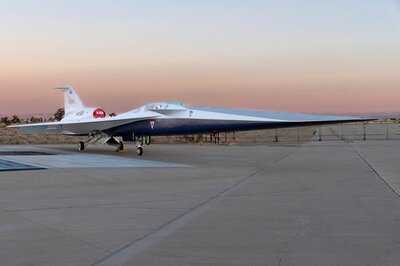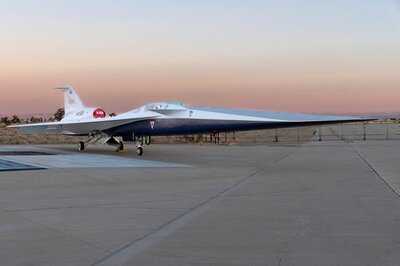
In a major milestone in the return of supersonic travel for passengers, NASA's experimental aircraft is making its maiden flight on Tuesday (October 28). The X-59 QueSST (Quiet SuperSonic Technology) is uniquely shaped to fly supersonically without waking a loud sonic boom - an issue that plagued the Anglo-French airliner Concorde.
The aircraft, designed and built by Lockheed Martin's Skunk Works at Air Force Plant 42 in Palmdale, California, is said to be helping to prepare for the return of supersonic airliners. According to NASA's website in June 2019, while the X-59 will never carry passengers itself, "it will likely kick off a new generation of quiet supersonic commercial planes that can fly over land and dramatically reduce the time it takes to get you across the U.S. and to other countries". Tuesday's flight, which involves a lower-altitude loop at about 240mph, has reportedly been planned to check critical onboard systems, as well as verify system integration, handling qualities, avionics and instrumentation.
The first flight also allows for the new aircraft to move from Palmdale to NASA's Armstrong Flight Research Center at the nearby Edwards Air Force Base.
After a couple of failed attempts, this milestone now marks the transition from ground testing to airborne operations in NASA's push towards quiet supersonic flight.
The Lockheed Martin X-59 Quesst, first designed in 2016, is expected to cruise at Mach 1.42 (937mph) at an altitude of 55,000ft. It should be capable of reaching a maximum speed of Mach 1.5 (990mph) and the aircraft takes its landing gear from an F-16. In 2018, it was estimated that the aircraft would have a sonic boom equivalent to a closing car door (75 EPNdB), compared to the 105-110 EPNdB for Concorde, which startled people and animals on the ground.
"Aircraft manufacturers may choose to include sonic-boom suppressing technologies developed for the X-59 in future designs of commercial supersonic aircraft," said NASA.
The data gathered from the X-59 flights will help the US's Federal Aviation Administration (FAA) and international regulators evaluate potential changes to existing rules that currently prohibit civilian supersonic flight over land. In fact, the FAA is preparing to replace the decades-old ban with new noise-based certification standards. This comes after Donald Trump's executive order in June, which directed the FAA to repeal the ban and allow overland supersonic flights for civilian aircraft.
Shortly after take-off, the QueSST jet rapidly climbed to the top of Flightradar24's "most tracked" aircraft list, with tens of thousands of people following its maiden flight, before it disappeared from the tracking website shortly after.
This news comes after it was revealed that supersonic planes could soon return to the skies, thanks to Boom Supersonic's new technology. The new plane, the Overture, is already in testing. The Overture would travel at Mach 1.7 and twice as fast over water, and United Airlines, American Airlines, and Japan Airlines have orders and preorders of Overture to fly within their fleets. The plane could hold 60-80 passengers and would cruise much higher than normal passenger jets at 60,000 feet.
You may also like

What does DEFCON 2 mean in House of Dynamite?

Cyclone Montha: Union Health Ministry reviews preparedness, assures necessary assistance to eastern coastal states

Cognitive confusion: Donald Trump refers to dementia screening as 'very hard' IQ test

Carlos Alcaraz issues worrying verdict after arguing with coach at Paris Masters

The Yorkshire Vet star tackles rare emergency as he admits 'I'm concerned'







